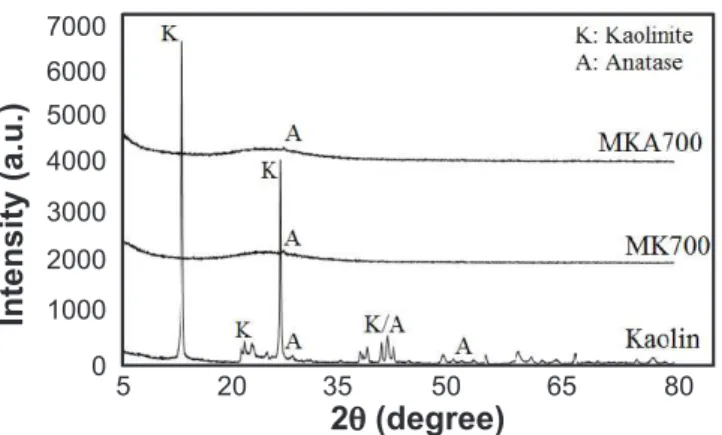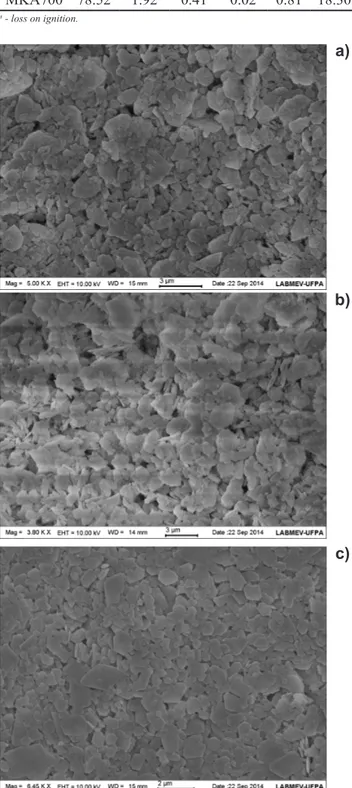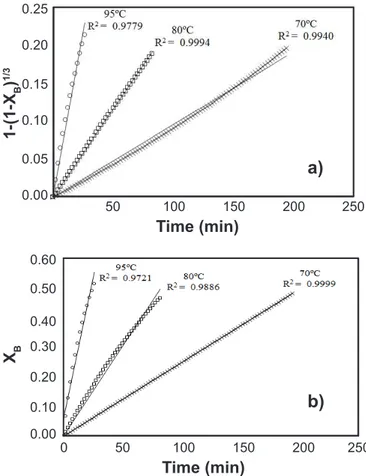INTRODUCTION
There are kaolin mines located in the Amazon region of northern Brazil, speciically in the states of Amapá (Rio Jari) and Pará (Rio Capim). Kaolin is mainly used in the paper industry as a iller and cover. However, it is also a possible source of metallic aluminum, porous silica, aluminum sulfate, chloride and nitrate [1-9]. Currently, bauxite is used for metallic aluminum production, but the limited availability of bauxite in the world makes researchers look for other available resources. Kaolin is a possible alternative to bauxite because it contains high alumina concentrations and is abundant in the Amazon region. The aluminum production process using kaolin can also produce silica with high speciic area [10-13].
The aluminum extraction from kaolin is carried out by irst performing the calcination and then the leaching process. The calcination of the kaolin promotes metakaolin production (Al2Si2O7) through the dehydroxylation process [14-17]. The metakaolin produced from calcination can then
be subjected to an acid leaching process which promotes aluminum dissolution [18]. The main acids used in this process are: hydrochloric, sulfuric and nitric acid [10, 13]. The following reaction represents the nitric acid leaching of metakaolin:
Al2Si2O7(S)+6HNO3(1)g2Al(NO3)3(1)+2SiO2(S)+3H2O(1) (A)
The kinetic study of this process has already been examined by many researchers. Hulbert and Huff [10] carried out a kinetic study of calcinated kaolin dissolution with three different acids: sulfuric, hydrochloric and nitric. Ajemba and Onukwuli [12] studied the dissolution kinetics and reaction mechanisms of Udi clay with an excess of nitric acid above 50% of the required stoichiometry. Phillips and Wills [19], Olsen et al. [20], and others studied the aluminum
dissolution process of kaolinitic clays. However, previous work found in the literature dealing with kinetic studies of metakaolin aluminum dissolution with nitric acid did not use Amazon metakaolin and used acid excess above 50%.
Dissolution kinetics of Amazonian metakaolin in nitric acid
(Cinética de dissolução de um metacaulim amazônico em ácido nítrico)
P. E. A. Lima1*, R. S. Angélica1, R. F. Neves2
1Programa de Pós-Graduação em Geologia e Geoquímica, Instituto de Geociências; 2Programa de
Pós-Graduação em Engenharia Química, Faculdade de Engenharia Química, Universidade Federal do Pará, R. Augusto Corrêa s/n, Belém, PA 66075-110
*paulaelissa@gmail.com
Abstract
The kinetic study of Amazon metakaolin dissolution was performed with the application of the shrinking core model for spherical and ‘lat plate’ particles with constant size. The Amazon kaolin was calcinated at 700 ºC in order to produce metakaolin. This metakaolin was leached with 5% excess nitric acid at 70, 80 and 95±3 ºC for 3 h. Samples were collected every 15 min and subjected to aluminum analysis. The acid leaching was a chemically controlled process. The spherical morphology showed better it than the lat plate particles when taking into account the regression coeficients. 91.58 kJ/mol of activation energy was found as well as an aluminum leaching reaction of the irst order. The results found in this work using 5% excess acid and Amazon kaolin were consistent with previous research results using excess acid above 50% and standard kaolin.
Keywords: kaolin, metakaolin, leaching, kinetic study.
Resumo
O estudo cinético da dissolução de um metacaulim amazônico foi realizado com a aplicação do modelo ‘shrinking core model’ para partículas esféricas e ‘placas planas’ com tamanho constante. O caulim amazônico foi calcinado a 700 ºC para promover a formação do metacaulim. O metacaulim foi lixiviado utilizando ácido nítrico com excesso de 5% a 70, 80 e 95 3 ºC por 3 h. Amostras foram coletadas a cada 15 min e submetidas à análise de alumínio. A lixiviação ácida realizada foi um processo quimicamente controlado. A morfologia esférica mostrou melhor ajuste matemático do que a morfologia de placa plana levando-se
em consideração os coeicientes de regressão obtidos. Foi encontrada uma energia de ativação equivalente a 91,58 kJ/mol, assim
como reação de lixiviação de primeira ordem em relação ao alumínio do metacaulim. Os resultados encontrados com a utilização de excesso ácido de apenas 5% e caulim amazônico foram consistentes com trabalhos realizados anteriormente, cuja metodologia utilizou excesso ácido acima de 50% e amostra padrão de caulim.
The high excess of acid which is recommended by literature for this kinetic study is not industrially viable. Therefore, the aim of this paper is to carry out a kinetic study of the metakaolin aluminum dissolution process using Amazon kaolin as starting material and then leaching it with nitric acid at 5% excess. The shrinking core model (SCM) is then applied for spherical and ‘lat plate’ particles with constant size.
MATERIALS AND METHODS
Materials: the starting materials were kaolin (a inal
product used for paper coating) from the Capim region in the state of Pará and nitric acid (65% purity). The nitric acid was used in concentrations to produce aluminum/acid rates similar to the reaction stoichiometry with 5% excess. The leachings were carried out in a reactor with a heating mantle capacity of 1000 mL, under constant stirring and reluxing, and coupled with a thermometer and a thermostat.
Methods: the kaolin was dried at 110 ºC and calcinated in
a mufle furnace at 700ºC for 2 h. The calcinated kaolin was named MK700. The non-calcinated kaolin and MK700 were leached with nitric acid at 5% excess. Leaching tests were carried out for 3 h with 50 g of sample. The non-calcinated kaolin was leached at 95±3 ºC and MK700 at 95, 80 and 70±3 ºC. Samples were collected every 15 min, iltered and subjected to aluminum analysis using EDTA titrimetric method. Leachings were carried out in duplicate and the solid residue was named MKA700. The mathematical adjustments were carried out in Microsoft Excel using the Solver tool with the hyperbole equation.
The materials were characterized before and after the calcination and leaching processes according to the following techniques: 1) X-ray diffraction analysis (XRD), using an X’PERT PRO MPD (PW 3040/60) from Panalytical, CuKα (Kα1= 1.54060 Å) radiation, Ni β ilter, 4º-75º (2θ), step size
of 0.017° (2θ), time/step of 20 s, voltage of 40 kV and slit width of 1/4º; 2) chemical analysis by X-ray luorescence spectrometry (XRF) using an Axios Minerals WDS, Panalytical spectrometer; 3) particle size distribution (PSD) using an Analysette 22 MicroTec Plus, from Fritsch; and 4) scanning electron microscopy (SEM) analysis in an LEO 1430 Zeiss equipment.
The shrinking core model (SCM) was used in the kinetic study for spherical and lat plate particles with constant size (heterogeneous reaction). The activation energy was calculated using the Arrhenius equation [13, 21-23]. Table I shows the equations used.
RESULTS AND DISCUSSION
Material characterization: Fig. 1 shows the XRD
patterns of kaolin for MK700 and MKA700. Kaolinite was predominant in kaolin, but small amounts of anatase were observed. MK700 and MKA700 were both shown to be in amorphous phase. Table II shows the chemical composition of these materials. The micromorphological analysis showed that the kaolin was composed of pseudo-hexagonal plates, which is typical of kaolinite. This micromorphological aspect remained even after the calcination and leaching processes which can be seen in Fig. 2 [24]. Concerning the PSD analysis (Fig. 3), the kaolin showed an average particle size (D50) of 3 µm. Calcination and leaching did not promote signiicant changes in the particle size, with D50 of 4.1 µm and 4.9 µm for MK700 and MKA700, respectively.
Acid leaching: the fractional conversions obtained from the leachings are shown in Fig. 4. The inal conversion values obtained were as follow: 95.9% at 95 ºC, 79.9% at 80ºC and 44.6% at 70ºC for MK700 and 4.5% at 95ºC for non-calcinated kaolin.
Kinetic study: the shrinking core model (SCM) was applied for spherical and lat plate particles with constant size with the chemical reaction as a determining step. The results found were similar (Fig. 5, Table III). Differences between the rate constant can be attributed to the changes in the reaction area considered. The reaction was of the irst-order with respect to aluminum from metakaolin and had an activation energy of 91.58 and 91.78 kJ/mol for spherical and lat plate particles, respectively. The spherical morphology showed a better it with regression coeficients very close to 1. Therefore, the results obtained for spherical particles were considered for the inal analysis of this study.
Some authors carried out metakaolin leachings with nitric B
t
= X ô
Morphology Equationsa
Flat plate
Sphere
a - (t) time, (τ) time for complete conversion, (X) conversion, (ρ)
molar density, (R) particle radius, (b) alumina stoichiometric, (k) rate constant, (C) reagent concentration, (L) length of the largest particle.
B s Af ñ L ô = bk C 1/3 B t
= 1 - (1 - X )
ô B s Af ñ R ô = bk C ; ;
Table I - Final equations of the shrinking core model for spherical and lat plate particles with constant size.
[Tabela I - Equações inais do modelo ‘shrinking core
model’ para partículas esféricas e placa plana.]
Figure 1: X-ray diffraction patterns of kaolin, MK700 and MKA700.
[Figura 1: Difratogramas de raios X do caulim, MK700 e MKA700.] 5 7000 6000 5000 4000 3000 2000 1000 0
2q (degree)
Intensity (a.u.)
35 65
20 50 80
acid. Hulbert and Huff [10] studied the kinetics of alumina removal from a calcinated kaolin with nitric, sulphuric and hydrochloric acids (excess above 90%). A nucleation model was applied and concluded that the reaction with respect to aluminum was of the irst order and had an activation energy of 108.68 kJ/mol. Ajemba and Onukwuli [12] investigated the dissolution kinetics and mechanisms of reaction of Udi clay in a nitric acid solution (excess above 90%). The clay was calcinated at 700 ºC and showed extractable alumina concentrations of 26.5% with a high concentration of Fe2O3 (18.45%) and the presence of interferents such as K2O, SO3, MgO and others. The leachings were carried out at temperatures between 30-70 ºC with maximum extraction being less than 70% at 70 ºC. They concluded that it was a chemically controlled process with reaction order and activation energy of 0.31 and 21.79 kJ/mol, respectively. The activation energy found in this study (91.58 kJ/mol), carried out in nitric acid with 5% excess, was consistent with the irst paper, but had a signiicant difference with the second
Figure 2: SEM micrographs of kaolin (A), MK700 (B), and MKA700 (C).
[Figura 2: Micrograias obtidas por microscopia eletrônica de varredura do caulim (A), MK700 (B) e MKA700 (C).]
Sample SiO2 Al2O3 Fe2O3 Na2O TiO2 LOIa
Kaolin 45.96 38.50 0.53 0.22 0.42 14.29
MK700 52.99 44.63 0.56 0.34 0.50 0.98
MKA700 78.52 1.92 0.41 0.02 0.81 18.30
a - loss on ignition.
Table II - Chemical composition of samples - major oxides (mass %).
[Tabela II - Composição química das amostras - principais óxidos (% em massa).]
a)
b)
c)
Figure 3: PSD curves of kaolin (non-calcinated), MK700 and MKA700 (d: particle size, D50: average particle size).
[Figura 3: Curvas de distribuição de tamanho de partícula do
caulim (não calcinado), MK700 e MKA700 (d: diâmetro de
partícula, D50: diâmetro médio de partícula).]
0.01
d (µm)
Cumulative relative
frequency
(%)
0.1 100
90
70
50
30
10 80
60
40
20
0
1 10 100 1000
Figure 4: Fractional conversions (X) of leachings with HNO3 at 95,
80 and 70 ºC for MK700 and at 95ºC for kaolin (non-calcinated).
[Figura 4: Conversão fracional (X) das lixiviações com HNO3 a 95, 80 e 70 ºC para o MK700 e a 95 ºC para o caulim (não calcinado).]
0 1.0
0.8
0.6
0.4
0.2
0.0
20 60 100
Time (min)
Conversion, X
140 180
paper. This difference was attributed to the starting material. The Amazon kaolin used in this work showed chemical composition not compatible with Udi clay, studied by Ajemba and Onukwuli, with low concentration of Al2O3 and
high concentration of Fe2O3. The starting material used in
this study had chemical composition similar to the standard samples of kaolin (Huber CW) used in [10] (42.9% Al2O3,
0,4% Fe2O3 and 1.8% TiO2). In the kinetic study, the high
purity gives a greater transparency because there are less errors involved. The kaolin from the Amazon region used in this study showed low concentrations of contaminants due to its sedimentary origin [8], with chemical composition close to standards samples of kaolin.
CONCLUSIONS
The results of the kinetic parameters obtained for spherical and ‘lat plate’ morphologies were similar. However, the regression coeficient values indicated that the spherical morphology showed a better it. The aluminum dissolution of metakaolin in nitric acid is a chemically controlled process, is a irst-order reaction with respect to aluminum and has an activation energy of 91.58 kJ/mol. The Amazon metakaolin studied in this work leached with nitric acid at 95 ºC and 5% excess showed maximum aluminum extraction (95.9%). These kinetic results are consistent with studies carried out previously with compatible starting materials and acid excess above 90%.
ACKNOWLEDGMENTS
The irst author thanks CNPq for a PhD scholarship. Financial resources for this work were obtained from the following projects related to zeolite synthesis from Amazon kaolin: MCT/CT-Mineral/Vale/CNPq nº 12/2009 (Process 550.297/2010-3) and nº 01/2010, FAPEMIG-FAPESP-FAPESPA-VALE (ICAAF nº 027/2011).
REFERENCES
[1] H.H. Morris, F.A. Gunn, Ind. Eng. Chem. 52, 5 (1960) 370.
[2] B.S. Carneiro, R.S. Angélica, T. Scheller, E.A.S. Castro, R.F. Neves, Cerâmica 49 (2003) 237.
[3] H.H. Murray, C.A. Alves, C.H. Bastos, Clay Miner. 42 (2007) 145.
[4] A.A.B. Maia, E. Saldanha, R.S. Angélica, C.A.G. Souza, R.F. Neves, Cerâmica 53 (2007) 319.
[5] W.N. Mussel, E. Murad, P.S.R. Criscuolo, P.G. Pinheiro, J.D. Fabris, Clay Miner. 43, 3 (2008) 381.
[6] A.A.B. Maia, R.S. Angélica, R.F. Neves, Cerâmica 54 (2008) 345.
[7] M.L. Costa, D.J.L. Sousa, R.S. Angelica, J. South Am. Earth Sci. 27, 2-3 (2009) 219.
[8] E. Santos, R.B. Scorzelli, L.C. Bertolino, O.C. Alves, P. Munayco, Appl. Clay Sci. 55 (2012) 164.
[9] M.S. Barata, R.S. Angélica, Cerâmica 58 (2012) 36. [10] S.F. Hulbert, D.E. Huff,J. Clay Miner. 8 (1970) 337. [11] A.A. Al-Zahrani, M.H. Abdul-Majid, JKAU: Eng. Sci.
Figure 5: Regression coeficients (R2) for: (a) spherical particle;
and (b) lat plate particle (XB: fractional conversion).
[Figura 5: Coeicientes de regressão (R2) para: (a) partícula esférica; e (b) partícula placa plana (XB: conversão fracional).]
T
(ºC) n k (minSphere-1) Ea (kJ/mol) n k (minFlat plate-1) Ea (kJ/mol)
70 0.99 0.0010
91.58
1.00 0.0025
91.78
80 1.00 0.0023 0.98 0.0060
95 0.91 0.0088 0.86 0.0222
a - n: reaction order; k: rate constant; Ea: activation energy.
0.25
0.15
0.05 0.20
0.10
0.00
Time (min)
1-(1-X
B
)
1/3
50 100 150 200 250
0.60
0.40
0.20 0.50
0.30
0.10
0.00
Time (min) X B
50
0 100 150 200 250
a)
b)
Table III - Results obtained with SCM for spherical and lat plate particles.a
20, 2 (2009) 29.
[12] R.O. Ajemba, O.D. Onukwuli,Am. J. Sci. Ind. Res. 3, 3 (2012) 115.
[13] P.E.A. Lima, R.S. Angélica, R.F. Neves,Appl. Clay Sci. 88-89 (2014) 159.
[14] G.W. Brindley, M. Nakahira,J. Am. Ceram. Soc. 42, 7 (1959) 314.
[15] S. Sperinck, P. Raiteri, N. Marks, K. Wright,J. Mater. Chem. 21 (2010) 2118.
[16] P.E.A. Lima, R.S. Angélica, T. Scheller, R.F. Neves, Cerâmica 59 (2013) 317.
[17] P.S. Santos, Ciência e tecnologia de argilas, 2nd Ed.,
Edgar Blücher, S. Paulo (1989).
[18] C. Belver, M.A.B. Muñoz, M.A. Vicente,Chem. Mater.
14, 5 (2002) 2033.
[19] C.V. Phillips, K.J. Wills,Hydrometallurgy 9 (1982) 15. [20] R.S. Olsen, W.G. Gruzensky, S.J. Bullard, R.P. Beyer, J.L. Henry, Report of Investigations RI8834, Bureau of Mines, USA (1983).
[21] O. Levenspiel, Chemical reaction engineering, John
Wiley, New York (1972).
[22] H.S. Fogler, Elements of chemical reaction engineering, Prentice Hall, New Jersey (1999).
[23] J.C. Kotz, P. Treichel, Chemistry and chemical reactivity, Saunders College Publ., Florida (1999).
[24] F. Bergaya, P. Dion, J.F. Alcover, C. Clinard, D. Tchoubar, J. Mater. Sci. 31 (1996) 5069.
(Rec. 20/10/2016, Rev. 18/03/2017, 22/05/2017, Ac. 20/06/2017)


